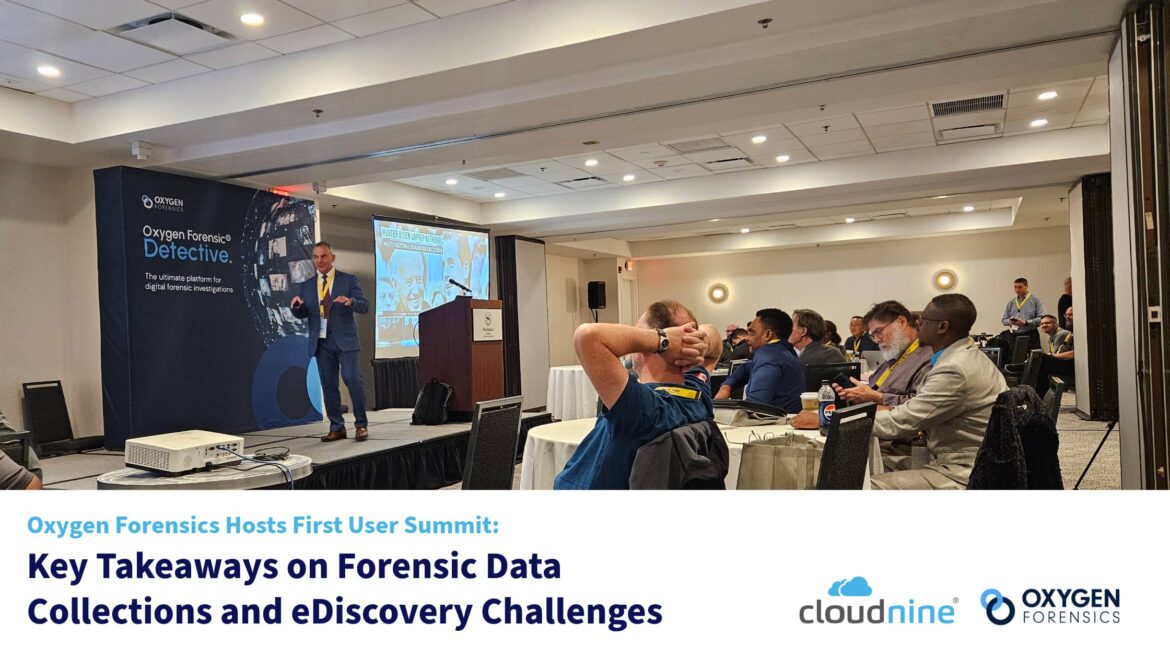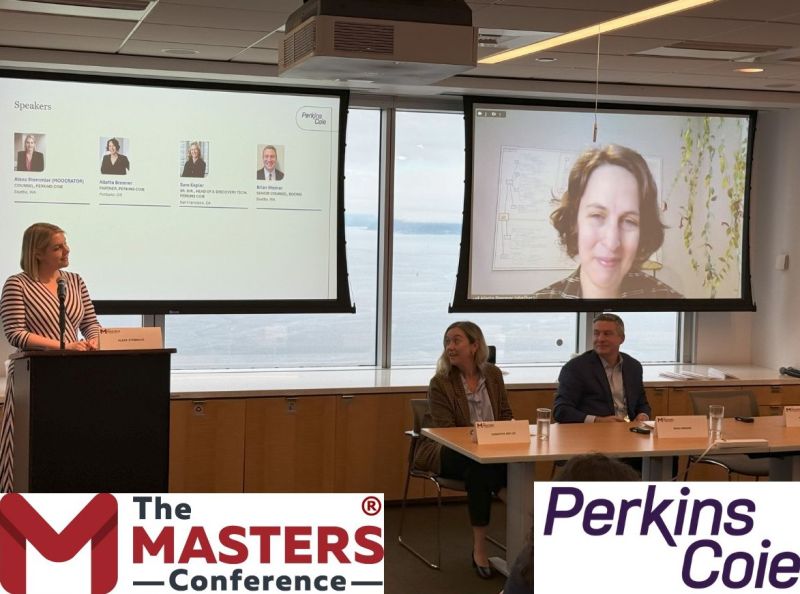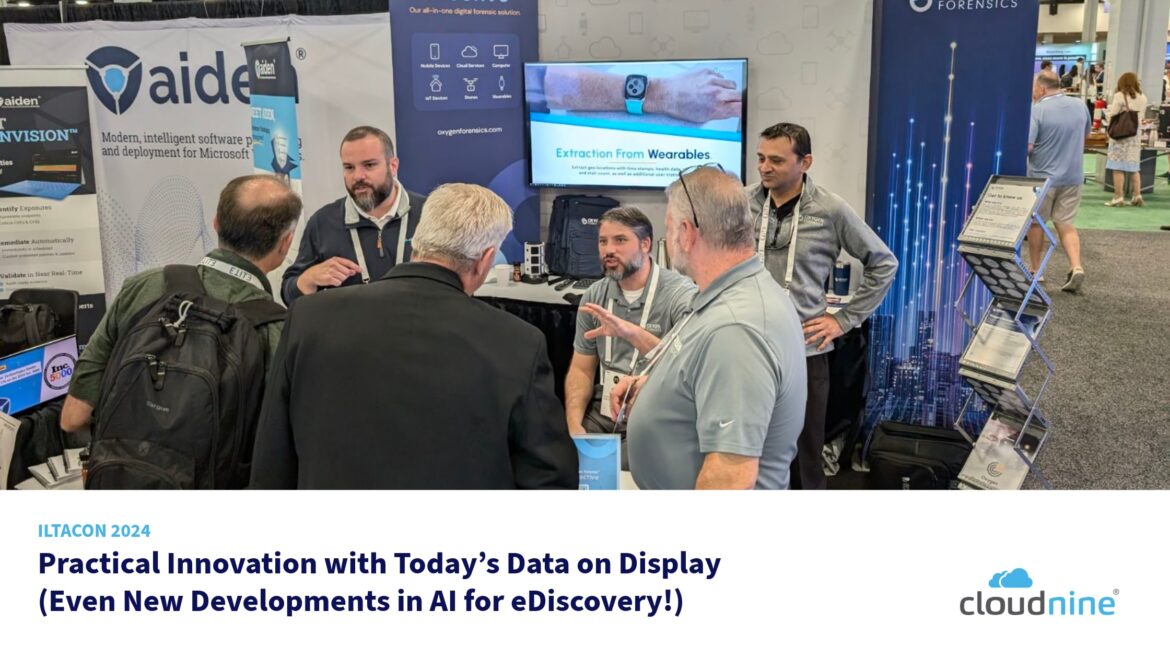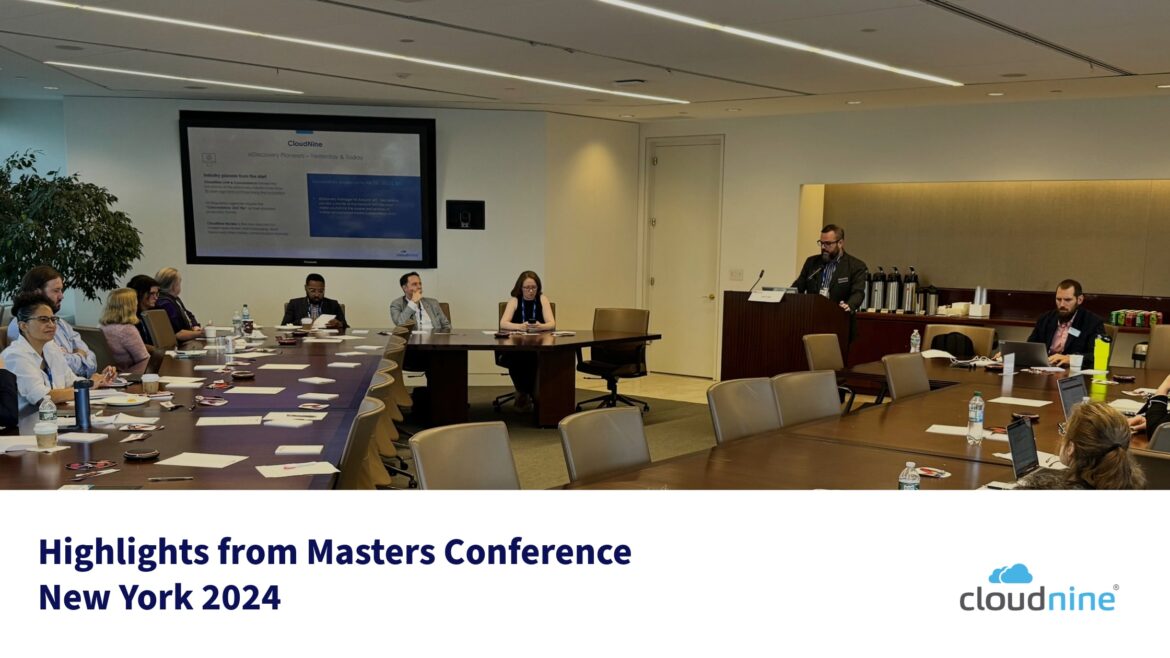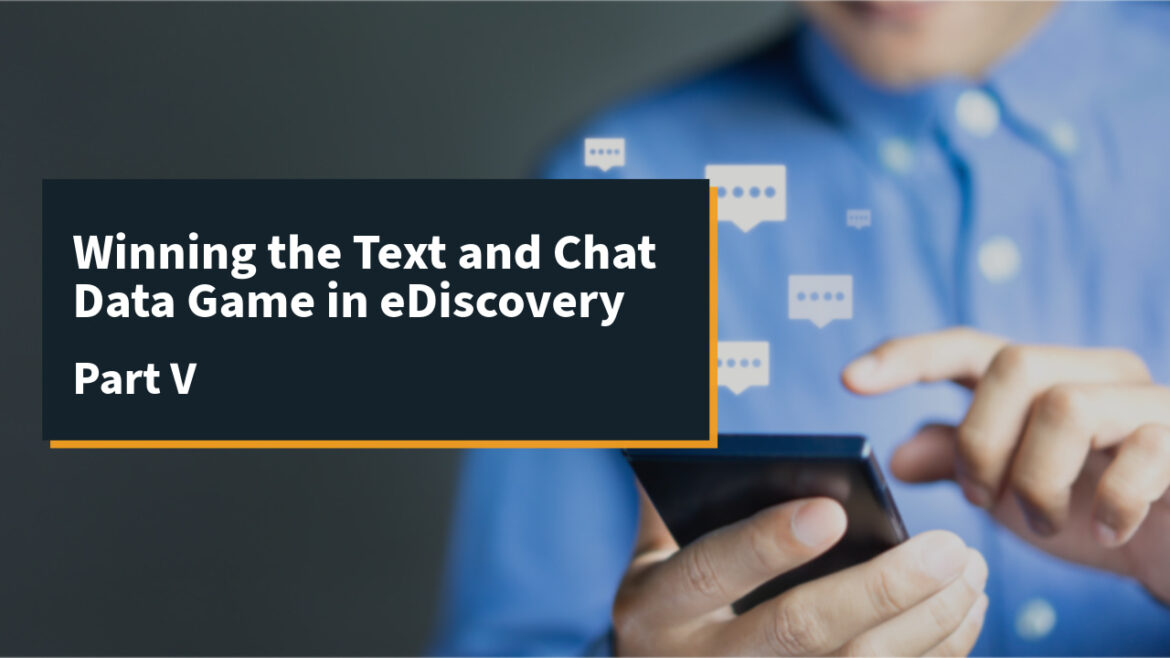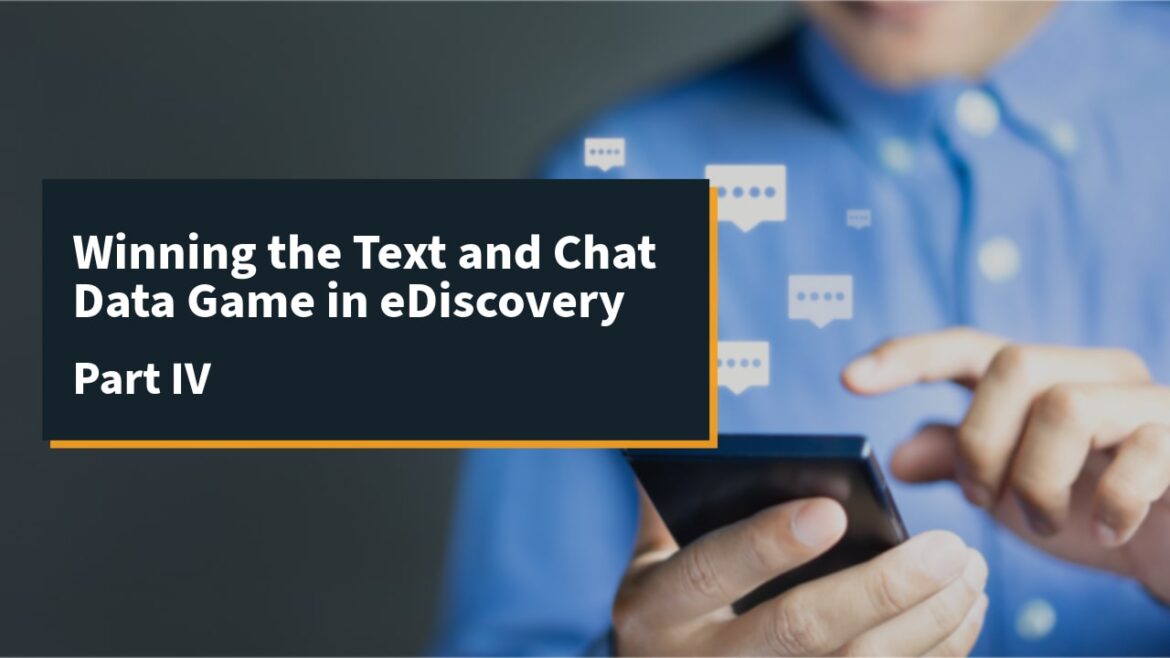By Rick Clark
The Masters Conference for Legal Professionals in New York City hosted by Morgan, Lewis & Bockius LLP on July 24th was replete with insights on applying AI to eDiscovery, collecting and reviewing text and chat app data and information governance. A second conference the following day was held on “soft skills” provided valuable tips on enhancing your communication skills and your career was emceed by Rich Robinson of Toyota. My take on the conference highlights follows.
At this year’s Masters Conference, I had the privilege of leading a breakout session titled “Navigating Modern eDiscovery: Native and Document Review Strategies for Communication Tools.” The room was filled with both new and familiar faces, promising a lively and insightful discussion. The session focused on the evolving landscape of eDiscovery, especially as collaboration platforms like Slack and Microsoft Teams become central to business communications, overshadowing the traditional reliance on email.
The rise of digital collaboration has significantly altered the document review collection process, which previously focused primarily on documents and emails. A recent State of the Industry report from eDiscovery Today highlighted that nearly 90% of corporate respondents now need to collect collaboration data for legal cases. This shift underscores the necessity for updated eDiscovery strategies that accommodate a broader range of communication tools. At a session we held earlier in the week with our managed review partner, Integreon, we also covered this topic and included a discussion on updating workflows between teams and choosing the right technology to match a modern data set. You can view more of their tips in their recently published blog, “Data, Documents and the eDiscovery Review Process – Are We Doing It Right?”
During our Masters Conference session, we introduced CloudNine’s latest release of our award-winning eDiscovery platform, CloudNine Review. This updated platform integrates traditional and native review methodologies, revolutionizing eDiscovery practices to handle any type of data in one unified platform. I discussed the challenges and solutions of managing electronic communications during the discovery process and emphasized how CloudNine’s native review approach enhances efficiency compared to traditional document-centric methods, whether dealing with chat logs, social media messages, or email threads. This approach helps to tell the whole story while saving time and reducing costs.
To provide a well-rounded perspective, I included insights from esteemed professionals in the audience, including Alex Lewis, Managing Partner of Kuro Group; Kelly Twigger, CEO of eDiscovery Assistant; and Liz Gary, Senior Associate at Morgan Lewis. Their contributions enriched the discussion, particularly when addressing the challenges of modern discovery.
I also referenced the “Internet Minute” graphic from 2023, illustrating the vast volumes and variety of modern data. Notable highlights included:
- Over 1 million organizations use Microsoft Teams, including 91% of the Fortune 100 companies (2024).
- In one year, more than 6 billion chats are sent via Microsoft Teams, and over 17 billion via Slack (2024).
- Text messaging, preferred for both personal and business communication, sees over 27 billion messages sent daily.
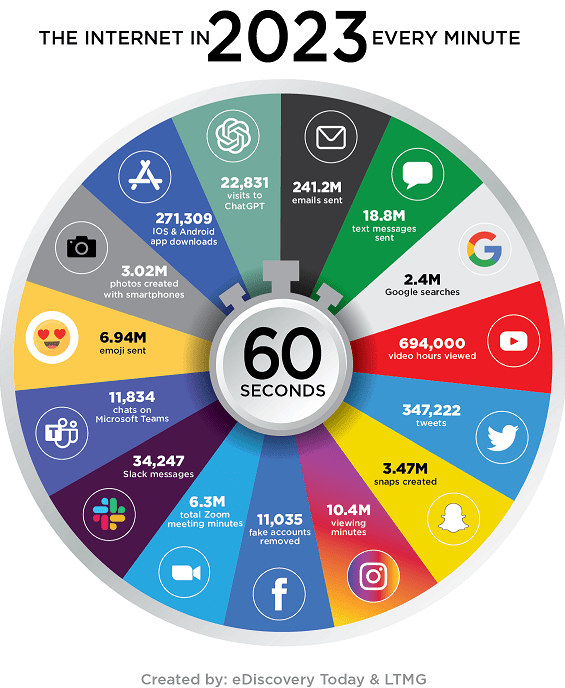
A poll conducted among CloudNine’s 20,000 LinkedIn followers revealed that 84% always or frequently encounter issues dealing with text or chat application data in eDiscovery, with Microsoft Teams posing challenges for 52% and Slack for 35%. A quick poll of the session’s attendees showed similar results, reflecting the widespread nature of these challenges.
We delved into common data requests for discovery, covering corporate chat applications (Slack and Teams), text messages, email and efiles, phone calls, voicemails, and other data types. The discussion highlighted several key issues:
- The tedious nature of converting data to documents before review.
- The difficulty of tracking cross-platform conversations that might start in an email, move to Slack, and conclude in WhatsApp.
- The expense and time consumption associated with getting modern communications converted to documents then loaded into traditional document review platforms.
- The increasing necessity for flexible production formats in response to varied production requests.
Despite these challenges, the session ended on a positive note, showcasing the capabilities of CloudNine Review. This flagship platform allows for the import, review, and production of all data types within a single platform, offering a seamless blend of native and document review workflows. Unlike other main review platforms that only support document review, CloudNine Review supports a comprehensive approach, addressing the needs of modern eDiscovery with greater efficiency and flexibility.
Overall, the session underscored the importance of adapting eDiscovery practices to accommodate the complexities of modern digital communication, ensuring that legal teams can manage and review data effectively in today’s rapidly evolving landscape.
The first session I was able to sit in on was a morning session was titled Is “Custodial” Discovery Dead? What the Rise of Chats and Collaboration Tools Means for Data Preservation and Production.”
Session Speakers:
- Kelly Twigger, CEO, ESI Attorneys
- Liz Gary, Sr. Associate, Morgan, Lewis & Bockius LLP
- Bansri McCarthy, Associate, Morgan, Lewis & Bockius LLP
- Andrew Peck, Senior Counsel, DLA Piper LLP
- Jessica Perazzelli Ross, Head of Global eDiscovery, SwissRe Group
In our new era where communication methods are rapidly evolving, it’s essential to question the relevance of email as the primary source of information. For discovery purposes, is the practice of relying solely on custodial email collections becoming obsolete? This session delved into the implications of the changing landscape of business communications for data identification, preservation, and collection.
Custodial Approach: An Outdated Model?
Traditionally, the custodial approach has been the cornerstone of data collection. Jessica Perazzelli Ross noted that this method served as the starting point for placing data on legal hold. However, Andrew Peck pointed out that the definition of a “document” has evolved from physical documents to emails and now to new collaboration platforms, reflecting the diversity of modern communication tools.
Bansri McCarthy emphasized that relying solely on custodians is no longer effective due to the proliferation of corporate communication channels. Critical data often resides in real-time platforms like Microsoft Teams, where documents are linked and accessible by many, making traditional custodial ownership obsolete.
Challenges with New Communication Tools
Liz Gary highlighted that while email remains a common business communication tool, the rise of group email boxes and distribution lists complicates data collection, requiring deeper investigation. This complexity was underscored by an audience question: is an “info@” email address a custodian? Gary’s response highlighted the need for thorough data assessment in modern communication channels. In other words, know what information is shared in those group-held email inboxes. Kelly Twigger added that a physical examination of data is necessary to determine its responsiveness.
Access and Preservation Issues
Peck discussed how access to collaboration platforms varies based on subscription levels, posing challenges for data preservation and collection. Twigger noted that Microsoft’s tiered enterprise access means not all employees need higher-level access, which affects data organization and preservation.
Ross mentioned that although the custodial approach remains a starting point for placing legal holds, additional data in SharePoint’s or Teams channels needs to be identified through custodial questionnaires.
Organizational Dynamics
Gary pointed out that communication structures in channels, where people come and go, require careful scrutiny to identify pertinent conversations. Twigger compared tools like Slack to MS Teams, noting the complexities added by their channel and conversation setups. Effective license management for these tools is crucial for data collection.
Non-Custodial Data Sources
Identifying responsible parties for non-custodial data sources is crucial, according to McCarthy. Twigger added that data maps, which once focused on email, now need to encompass various data sources for effective information governance.
Preservation Triggers and Compliance
Peck explained that preservation triggers vary by case. Internal disputes might not require preservation unless escalated to an external body like the EEOC. Keeping pace with the expanding scope of litigation is critical to avoid spoliation fines. Whether ESI protocols are court-mandated or agreed upon, they come with compliance obligations. Court orders, in particular, can lead to sanctions under Rule 37(b).
Roles and Responsibilities
Twigger noted that custodians often lack the knowledge for preservation processes, necessitating collaboration with IT. However, IT should not bear legal responsibilities. Ross emphasized that eDiscovery bridges legal and IT departments. Maintaining data maps and having key data sources and personnel ready for preservation are vital. An in-house eDiscovery professional can effectively translate legal requirements into IT actions.
Peck added that knowledgeable in-house eDiscovery attorneys facilitate the discovery process for outside counsel, who certify discovery processes per Rule 26(g).
Emerging Data Complexity
Gary suggested that additional data collections might be warranted if referenced in conversations. Detailed notes from custodial interviews help ensure comprehensive data awareness. Twigger emphasized that the increasing complexity and volume of data shorten discovery timelines, making robust processes essential.
The session underscored the shifting landscape of data discovery, emphasizing the need for adaptive strategies to manage the growing variety and volume of modern business communications.
The next session I was able to attend was a deep dive into how employees are now communicating on platforms other than simply email.
Regulatory Focus: Off-Channel Communications and Emerging AI Governance
Session Speakers:
- Mike Gaudet, Managing Director, JS Held
- Antonio Rega, Managing Director, JS Held
- Yohance Bowden, Sr. Associate Counsel, Metropolitan Transit Authority (MTA)
- James Sherer, Partner, Baker Hostetler LLP
- Kiriaki Tourikis, Counsel, Reed Smith LLP
The session covered two pressing topics: the complexities of off-channel communications and the emerging governance of artificial intelligence (AI). With the ongoing evolution of remote work and advancements in AI, understanding regulatory and compliance frameworks is crucial.
Off-Channel Communications: Navigating the New Normal
James Sherer kicked off the discussion by highlighting the increasing prevalence of off-channel communications, a trend that has surged with the work-from-home culture established during the pandemic. This shift has persisted, presenting new challenges in data management and compliance.
Kiriaki Tourikis emphasized that despite the pandemic-induced changes in work environments, the obligations for data preservation remain unchanged. Organizations must understand their baseline data preservation strategies and the applications they use, which could impact litigation.
Yohance Bowden noted that companies often issue mobile devices to expedite communications, which introduces additional layers of complexity in managing these devices.
Antonio Rega elaborated on the concept of Bring Your Own Device (BYOD) or Company Issued Device (CID) policies, which vary based on business needs or regulatory requirements. In regulated industries, agencies like the SEC mandate third-party audits to ensure compliance with business use of these devices. Such audits involve extensive keyword searches and raise privacy concerns regarding the distinction between personal and business use.
Tourikis stressed the importance of training employees on the appropriate use of corporate chat applications and implementing consequences for non-compliance. Despite such measures, violations—whether due to negligence or malintent—still occur, necessitating clear management and enforcement steps for policy breaches.
Regulatory Take on Artificial Intelligence
The session transitioned to the regulatory perspectives on AI, with Sherer stating that agencies like the FTC and DOJ assert that companies cannot delegate away their responsibilities. Organizations must understand their AI implementations and identify who is accountable for the outcomes. It’s also crucial to have clear explanations for the use of AI technologies.
Rega brought attention to chatbots, which have become ubiquitous and collect vast amounts of conversational data. He questioned whether these conversations should be subject to collection and how this impacts privacy.
Tourikis added that it is essential to understand the content and context of chatbot interactions. Organizations need to analyze the validity and value of these conversations and determine the appropriate retention periods for such data.
Sherer noted that most chatbots, especially those on websites, are typically “out of the box” solutions that may not always align with specific business needs. If a chatbot conversation replicates what would typically be a human interaction, it likely needs to be preserved.
Rega highlighted that many countries are adopting a cautious approach to AI deployment due to regulatory and privacy concerns.
Public Records Requests and AI Challenges
Bowden discussed the complexities of fulfilling public records requests at the Metropolitan Transport Authority (MTA), particularly in the context of FOIL (Freedom of Information Law for the state of New York) releases. Some requests, such as those for audio source files of train announcements, pose security risks. The concern is that such files could be manipulated using Generative AI (GAI) programs, potentially compromising the train’s operating system.
Rega concluded by noting that GAI programs still require human oversight due to potential challenges and inconsistencies in AI-generated outcomes.
The session underscored the importance of staying abreast of regulatory changes and implementing robust governance frameworks to manage the complexities of off-channel communications and AI technologies effectively. As these areas continue to evolve, organizations must be proactive in addressing compliance, privacy, and security concerns.
The last session of the first day was a thoughtful discussion on how we may be able to quantify elements of legal practices, especially in eDiscovery.
Quantifying the Unquantifiable in Discovery
Session Speakers:
- Joe Pirrotta, ProSearch
- Shana Pederson, Morgan, Lewis & Bockius LLP
- Melissa Heidrick, mmData
- Monica Harris, Harris Consulting
The practice of discovery has seen significant evolution over the years, developing mature functions and frameworks for managing the process. We’ve created methods and tools to quantify various factors impacting the cost, quality, and efficiency of discovery—such as data volume, document types, review rates, accuracy, and responsiveness. However, certain aspects of discovery remain challenging to measure, such as the complexity of a case, the skill of the reviewers, the strategy of opposing counsel, and the value of the information. How do we quantify these “unquantifiables?”
In this session, panelists discussed how to navigate the grey areas of discovery when the data does not provide clear answers or guidance. Attendees learned about using critical thinking, risk assessment, and scenario planning to make informed decisions amid uncertainty. The panel also explored how to communicate rationale and evidence to courts, peers, and opposing parties, and how to handle challenges and disputes when the answer is “it depends.”
Managing Uncertainty
One of the primary challenges in discovery is predicting what will be produced and the associated costs. Shana Pederson highlighted that clients often ask for these estimates before diving into the data, requiring practitioners to provide reasonable guesstimates with the caveat that these might change as more information becomes available.
Melissa Heidrick emphasized the temptation to rely on historical data and processes during early data assessments. However, given the increasing variety and volume of data, each case must be approached uniquely to avoid limiting access to critical evidence.
Monica Harris stressed the importance of early data assessment in determining the types and volumes of data involved, which then informs the development of an ESI protocol. Setting clear expectations is crucial, as eDiscovery will vary in volumes, costs, and other variables across cases.
Transparency is key, according to Shana Pederson. Open communication helps manage expectations throughout the process and fosters trust and buy-in from stakeholders. Acknowledging that things can change even within a single case helps set realistic expectations and avoids potential issues.
Return on Investment
Discussing the return on investment (ROI) in discovery, Harris shared that as a product manager dealing with emerging technologies, there isn’t a one-size-fits-all answer for measuring ROI. Proof of concepts (POCs) are invaluable for learning and validating new processes.
Pederson agreed, noting that while it is difficult to quantify ROI for new data types, POCs provide essential insights. As the industry learns to manage new data types, similar to how it adapted to managing email 15 years ago, predictions about volumes and costs will improve.
Heidrick added that while conducting a POC, having a baseline for benchmarking against past projects is important. Even if the new data is vastly different, a baseline helps measure progress and effectiveness.
The Value of Wisdom
The session concluded with a discussion on the value of wisdom in the discovery process. Harris emphasized the importance of mentors within the industry, who can provide guidance and support. Surrounding oneself with mentors and being present in the community helps navigate challenges and learn from others’ experiences.
Heidrick reinforced the significance of mentorship, highlighting that mentors who have “climbed their mountain” are invaluable resources. Paying attention to the present moment and learning from the community can prevent repeating past mistakes and foster growth, but seek out those mentors as they won’t automatically offer up mentorship.
Pederson shared a philosophy of teaching with mindfulness and learning with gratitude, which resonated with the panel. Harris noted that mistakes often provide the most valuable lessons. Emotional intelligence, such as understanding the underlying needs in peers’ requests, is crucial for effective communication and problem-solving.
Heidrick concluded with advice on addressing bad news promptly. “Bad news doesn’t age well,” she said, recommending that bad news be delivered upfront rather than attempting to fix issues independently.
This session underscored the importance of adaptability, transparency, and the collective wisdom of the community in managing the unquantifiable aspects of discovery.
Day 2 – The Masters Conference Legal Power Skills with Rich Robinson
Then there was an add-on conference day which was an energy infused professional development day of topics in the arena of “Legal Power Skills” that was also hosted by Morgan Lewis and emceed by Rich Robinson. Robinson thoughtfully put together a day of legal power skill specifically catered to the legal industry as he has always had a passion for legal operations that includes power skills. His pillars of the skills are leadership, collaboration, communication, adaptability, emotional intelligence, and ingenuity. I attended most of the sessions and I walked away feeling refreshed, excited and knowing I have a lot to apply to personal life and professional career and captured below my takeaways from the sessions I was able to attend. The last session was a recorded “Dear Legal Ops” podcast, and you can listen to the episode here.
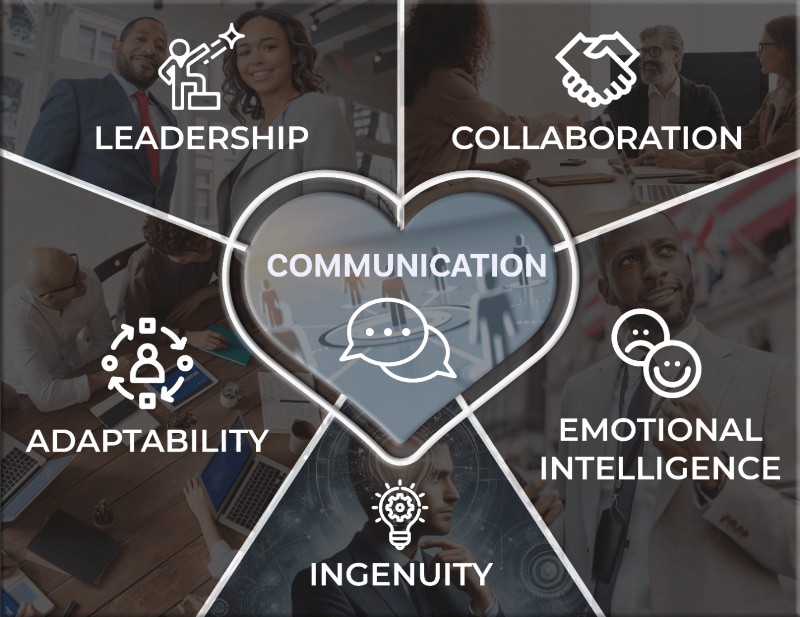
The industry’s ubiquitous Cat Casey kicked off the event with a thoughtful presentation then panel session on how to build your personal brand: Communication – Speak Up, Stand Out: Your Legal Branding Playbook with Cat Casey
In today’s competitive legal landscape, having a strong personal brand is essential. It’s not just about professional achievements; it’s about what people say about you in the room and beyond. Cat Casey’s session, “Speak Up, Stand Out: Your Legal Branding Playbook,” explored the nuances of personal branding and offered a comprehensive guide for legal professionals looking to differentiate themselves.
Your Personal Brand: Casey emphasized that everyone has a personal brand, which starts with understanding your “why.” This foundational element informs your approach to branding, whether through LinkedIn, social media, or other platforms. She stressed the importance of authenticity, advising attendees to start with their core values and what sets them apart from other lawyers. By focusing on their niche and building a solid visible identity or writing style, legal professionals can create a distinctive and genuine brand.
Understanding Personal Branding: Brian Meegan shared his perspective, highlighting that a brand goes beyond social media; it’s about how you want people to perceive you. Maribel Rivera described personal branding as the feeling people get when you are in the room and how you uplift and inspire others. Scott Milner spoke about legacy—his journey from a contract attorney to leading a global practice—and how his brand is about trailblazing and lifting everyone around him.
Investing in Your Brand: Rivera emphasized that her brand is rooted in her values, particularly family and transforming individuals from feeling like victims to warriors. She spoke about the importance of constant education and stepping out of her comfort zone. Meegan, drawing a parallel to his role as a drummer in a band, explained how he excels as a middle manager, supporting both the CEO and the team while extracting the best from those around him. Casey pointed out that your brand sticks with you, not necessarily your company, though it benefits the company as well.
How Your Why Shapes Your Brand: Casey noted that branding is an equalizer, allowing individuals to change their circumstances regardless of the cards they are dealt. Milner shared his experience with LinkedIn, where he incorporates personal elements alongside his professional life. He credited his mentor, Tess Blair, for helping him build his brand and emphasized the importance of being available to support colleagues’ growth. Rivera highlighted the significance of surrounding yourself with people who hold you accountable and support your authentic self. She recommended having a network that includes people who are where you were, where you are now, and where you want to go, and investing in an executive coach.
Secret Personal Brand Weapons: Meegan revealed that his secret weapon is the creativity of the people he works with. Rivera cited empathy, community, and authenticity as her key strengths, stressing the importance of being vulnerable and sharing her true feelings with those she cares about.
This session underscored the critical role of personal branding in the legal field. By understanding and embracing their unique values and strengths, legal professionals can create a powerful and lasting impact both within their organizations and in the broader community.
Ingenuity – Leveraging Design Thinking Principles to Transform Legal Perspectives on Technology with Scott Milner
In the evolving landscape of legal technology, Milner’s session on leveraging design thinking principles offers a fresh perspective on how the legal profession can embrace technology as a transformative ally rather than just a tool. The session delves into overcoming the deeply rooted status quo bias and cognitive fixedness that often hinder innovation in law firms and legal departments.
What is Disruption? To truly become a disruptor and prepare for inevitable changes, it’s crucial to have the right people in place. Disruption, often perceived as a threat, should be seen as an opportunity long before it becomes one. This perspective shift is central to embracing design thinking principles, which start with defining the problem and overcoming barriers like cognitive fixedness, status quo bias, and the failure to address pain points.
Insights from the Panel: The panel featured industry leaders who shared their experiences and insights on navigating the challenges of legal innovation:
- Angelique Harris, VP and eDiscovery Counsel at Barclays: Harris emphasized the importance of not being afraid to speak up if you believe you are bringing value or need to learn something new. This openness can lead to opportunities and even dream jobs.
- Farrah Pepper, Chief Legal Innovation Counsel at Marsh McLennan: Pepper shared that claiming roles that resonate with you is crucial. Throughout her career, she often took paths that aligned with her gut feelings, even when those paths diverged from traditional career growth expectations.
- Jessica Jones Escalara, Managing Director and Head of Legal Operations: Escalara highlighted the necessity of empathy in innovation. By putting yourself in the shoes of others and understanding their perspectives, you can bring them along on the journey of change.
- Jeremy Burdge, COO at Eltemate, Hogan Lovells: Burdge encouraged being proactive with innovative ideas, even if it means implementing processes before officially asking for the firm’s investment. This approach demonstrates commitment and feasibility.
Addressing Failures and Headwinds: The session also addressed the inevitable failures and headwinds that come with innovation:
- Harris: Emphasized the importance of not taking things personally and being open to criticism. Tough conversations are essential for personal and professional growth.
- Jones Escalara: Encouraged persistence, noting that a single failure doesn’t dictate future outcomes. Trying different approaches can eventually lead to success.
- Milner: Warned against coercion in implementing new platforms or changes, as it often leads to stronger resistance. Instead, fostering an environment of curiosity and creativity is key.
- Burdge: Highlighted the necessity of embracing failure, supporting team efforts, and refining approaches. Incremental wins can drive significant achievements over time.
Leveraging External Insights: Milner also advised learning from other industries to gain new perspectives. Successful practices from diverse fields can provide valuable insights that help in navigating and innovating within the legal profession.
Milner’s session underscored the transformative potential of design thinking principles in the legal field. By redefining disruption as an opportunity and embracing empathy, curiosity, and persistence, legal professionals can navigate the complexities of technological innovation. This approach not only enhances individual careers but also drives collective progress within the legal industry.
The second to last session was a unique and engaging presentation on Crisis Management. Though this topic is rarely discussed in our legal eDiscovery industry, it was an informative look into how corporate executives can be trained on how to work with the media in times of crisis or simply releasing a product to the market. Eric Chilton, President of Broadcast 2 Go and meteorologist for Channel 2, Greensboro, NC, walked us through how the media works in general, how to prepare your 15-second soundbite, and even some things on what NOT to do.
Leadership – Crisis Management with Eric Chilton
In the fast-paced world of media, understanding how to navigate crisis situations is crucial for effective leadership. Chilton’s session on crisis management emphasized the importance of media strategy and preparation, providing invaluable insights for leaders across all industries.
Understanding the New Media Landscape Chilton began by highlighting the vast influence of media, encompassing everything from devices and social feeds to traditional television and radio. He pointed out a critical trend: the average TV newsroom has experienced a 30% reduction in staff. This downsizing means that stories are often produced quickly, with reporters having only a few hours to film, conduct interviews, and gather supplementary footage (b-roll). As a result, news stories are typically condensed into 90-second segments, with sound bites lasting only about 15 seconds.
This condensed format requires those being interviewed to be concise and precise with their messaging. Chilton emphasized the importance of preparing key messages in advance, calling it a preamble, ensuring they can be communicated clearly and effectively within the short time frame available.
The Art of the Preamble One of the session’s key takeaways was the importance of a well-crafted preamble. This introductory statement, infused with a touch of emotion, sets the tone for the message and can help pivot from a reporter’s question to the intended message. Chilton underscored the power of emotion in communication, using a Maya Angelou quote to illustrate the point: “I’ve learned that people will forget what you say, people will forget what you did, but people will never forget how you made them feel.” A compelling preamble can leave a lasting impression, making it a vital component of any media interaction.
Crisis Management Training When working with C-suite executives, Chilton focuses on developing “interview muscle memory.” This involves one-on-one sessions where the executive and Chilton brainstorm potential preambles and key messages. They also conduct mock interviews, complete with a videographer, to simulate real-life scenarios. This hands-on approach provides immediate feedback, helping executives refine their delivery and messaging. The goal is to develop custom, branded messages that resonate with audiences and reflect the company’s values.
Presentation Tips Chilton also offered practical advice on appearance while on camera. He advised keeping clothing patterns simple and avoiding white shirts without a jacket, which can be visually distracting on camera. The focus should be on the interviewer, not the camera, to maintain a natural and engaging presence. Vocal inflection and hand gestures should be balanced to avoid a monotone delivery or overly animated movements.
These insights are not just applicable to crisis management; they are also valuable for anyone looking to build their professional brand. By mastering media interactions, leaders can effectively communicate their message, manage public perception, and navigate crises with confidence.
Normally after two days of conferencing (let alone doing an ILTA Roadshow on Tuesday) I am exhausted, but the Legal Soft Skills presentations energized all of us and we had a lot to talk about at the happy hour that followed at the legendary The Campbell at Grand Central Station. I am hopeful that Rich Robinson’s conference works its way around the country with the other Masters Conferences for Legal.
If you are interested in learning more about tackling modern data, download our guide, “The Ultimate Guide to Handling Text and Chat Data in eDiscovery” here and contact us for a demo of CloudNine Review.
You can also see us at ILTACON 2024 in Nashville, August 11-14. Stop by booth 752 to meet our collections partner, Oxygen Forensics, and me and get a look at how together we can help you speed your digital evidence collection, analysis and review. Not attending ILTA but want to learn more? Register today for our ILTA webinar on August 21 at 1 pm ET on streamlining digital evidence collections and reviews, hosted by Oxygen Forensics and CloudNine.

